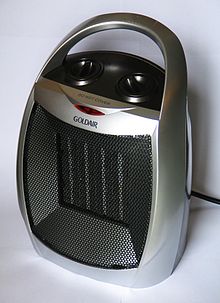- Ceramic heater
-
Ceramic heaters are space heaters that generate heat by passing electricity through heating wires embedded in ceramic plates. The plates heat aluminium baffles, and a fan blowing across the baffles heats the air.[1] Ceramic heaters are usually portable and typically used for heating a room or small office, and are similar to metal-coil fan heaters.
Contents
Technical infrared radiators
Contrary to natural IR radiation sources (e.g. the Sun, flames) the sources discussed here use technical means to produce IR radiation.
The following explanations explicitly do not include IR products which are used for purposes other than for warming such as IR transmitters or astronomical and military detection systems.
The IR radiator as a heating element
The IR radiators discussed here are technically constructed units designed for the purpose of transferring as much of the input energy (electricity, natural gas) as possible into warmth which is delivered by a radiating surface.
Independent of the design of the IR radiator the target always is that a maximum amount of emitted radiation will be transported, independent of any other transport medium, in a range of wavelengths which heat up the material with a minimum loss of energy.
It is to be noted that it is the technical design of these infrared radiators which causes them to emit in a certain range of wavelengths (e.g., the range of 2 to 10 µm).
Effects on radiated material
The differing atomic structures of materials to be warmed means that each has its own spectral range at which it best absorbs the emitted radiation. Each material has its own rate of absorption. Radiation which meets material which cannot absorb it will either let it pass through or reflect it.
The absorption process at the warmed up material is therefore always proportionate between reflected and transmitted radiation. A 100% absorption rate is technically not possible. Complete absorption exists only theoretically in the model of a “black emitter” or “black body”.
The ceramic infrared radiator
The ceramic infrared radiator consists of a resistance heating wire which is fully embedded in adequate ceramic material. By being fully embedded the energy produced is transferred to the ceramic material. This also protects the wire against overheating and extends its lifespan. The material in which the wire is embedded is electrically non-conducting and should have very good absorption and emission characteristics which allow it to radiate or emit in the desired range of wavelengths. These are factors which allow ceramic radiators to be produced in a large variety of geometric forms.
Ceramic infrared radiators are ceramic bodies which, through the use of a heating wire, use a part of their surface to produce IR radiation. It is also possible to have a thermocouple embedded in the ceramic material in direct proximity to the heating wire.
The inventor of the above mentioned ceramic heater is the company Elstein-Werk from Germany. For the basic model of the ceramic radiator as a bulb with screw-cap, the patent for Elstein was issued at 24th of March 1949. Concomitantly there was the development of laminar ceramic infrared radiators in order to realize the construction of large heating panels. The patent for these panel heaters was issued at 8th of March 1950 for Elstein-Werk. The worldwide usage of the word “Elsteinheater” is the generic term for it.
References
- ^ Dakss, Brian (Feb. 9, 2005). "A Guide To Space Heaters". CBSNews.com. http://www.cbsnews.com/stories/2005/02/09/earlyshow/contributors/dannylipford/main672592.shtml. Retrieved 15 January 2011.
Categories:- Heaters
Wikimedia Foundation. 2010.

